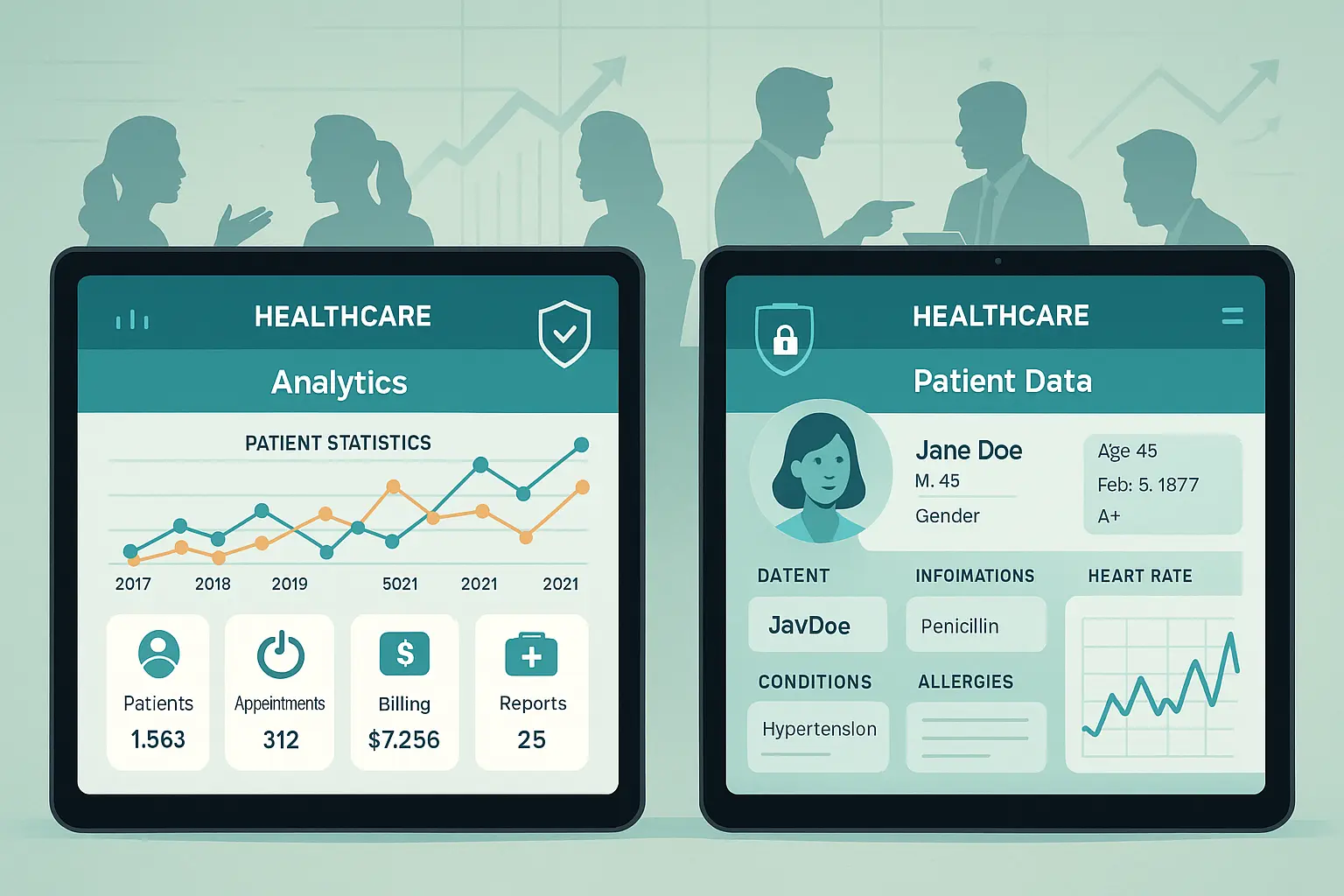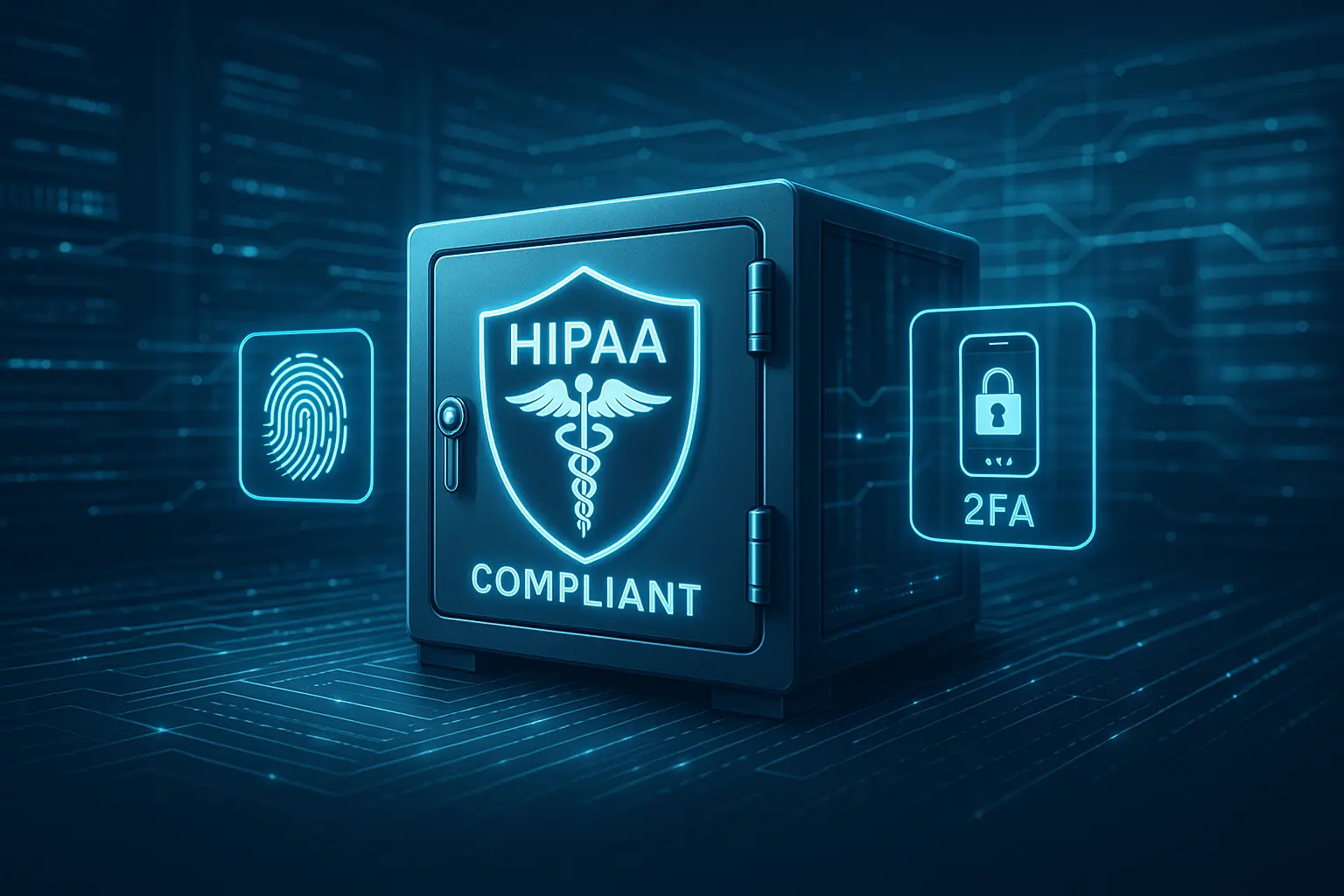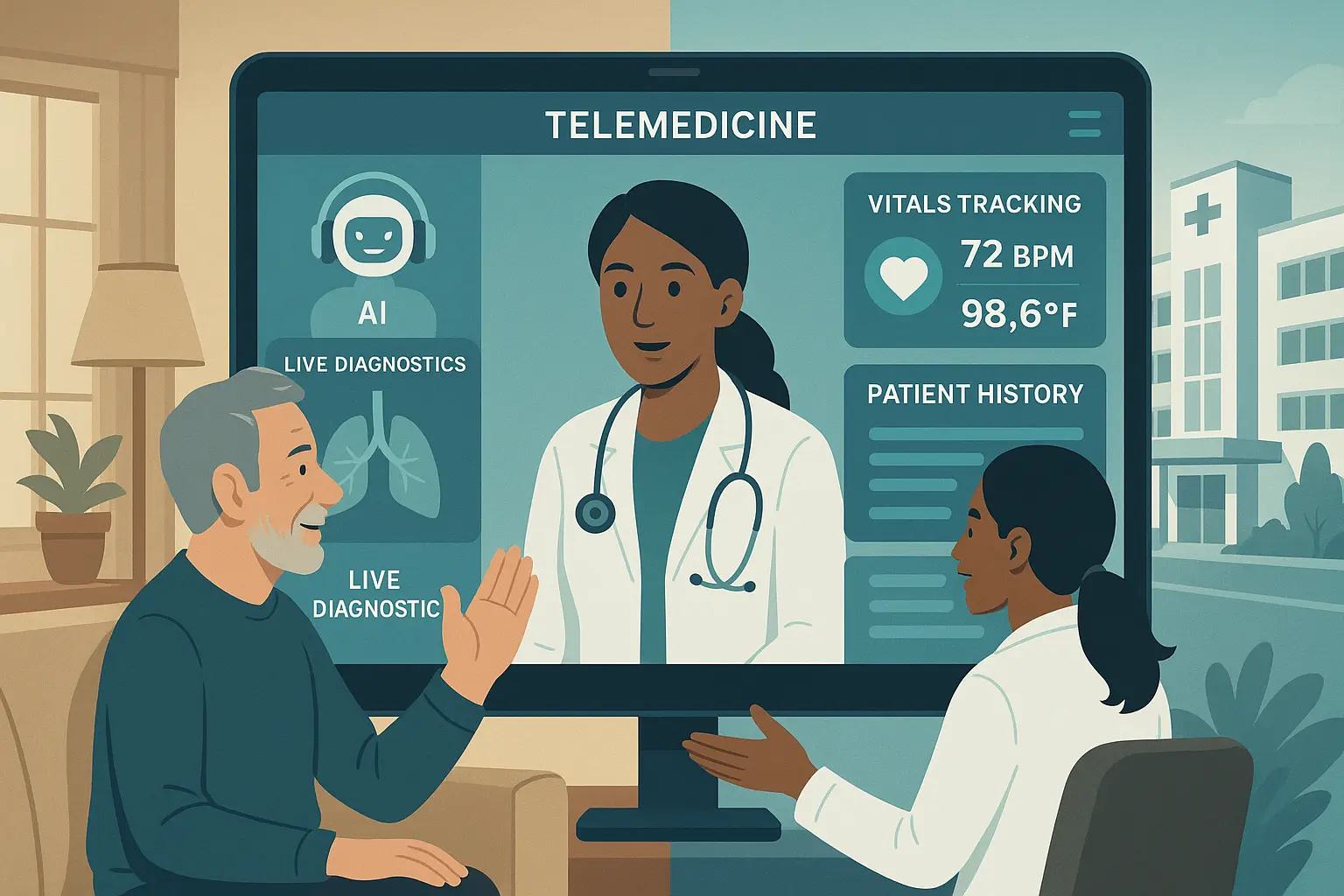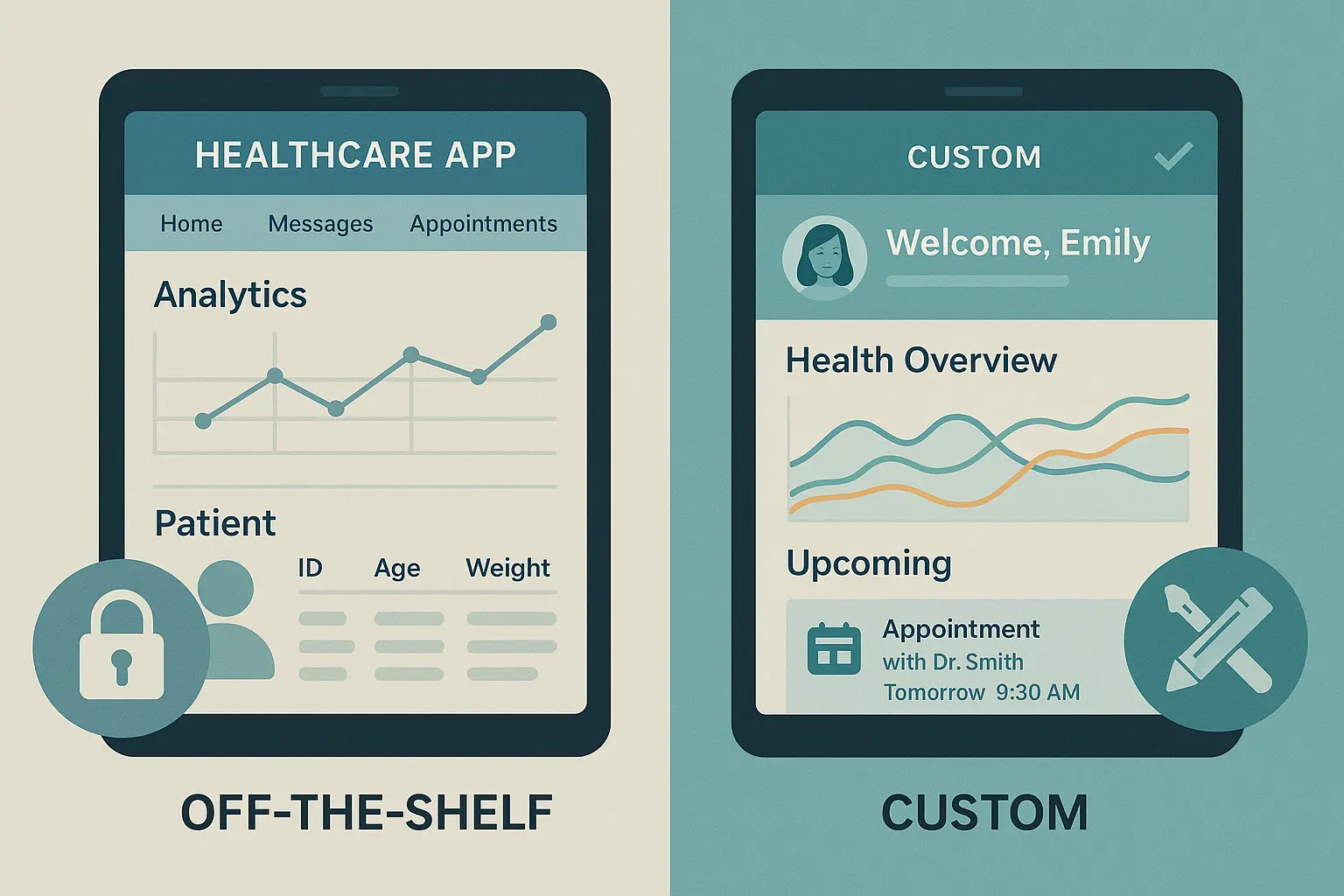Table Of Contents
Market Trends and Competitive Landscape
HIPAA Compliance and Security in Healthcare Apps
Telemedicine and Patient Management Software
Innovative Technology Integrations
Rapid MVP Development and DevOps Practices
Case Studies and Success Metrics in Healthcare Digital Transformation
Tools, Templates, and External Resources
Integrating Custom Software Solutions for Healthcare
The Role of Agile and Continuous Improvement
Best Practices for Secure Data Management
Comparative Analysis: Custom vs. Off-the-Shelf Solutions
Key Takeaways for Healthcare App Developers
Implementing a Comprehensive Healthcare App Strategy
Enhancing User Experience Through Thoughtful Design
Bridging Innovation and Compliance
Frequently Asked Questions (FAQs)
Key Takeaways
Choosing the right healthcare app development company is key for improving patient care and meeting organizational needs.
Focus on companies that emphasize security and compliance with regulations like HIPAA to protect patient data.
Keeping up with tech trends helps in enhancing applications, and using tools like AI and cloud services can boost functionality.
Cooperation with development teams that understand unique needs leads to better custom software and mobile app solutions. Tridev Technologies is here for startups and enterprises looking to level up and grow.
A user-friendly interface is vital; applications must cater to both patients and healthcare providers to promote engagement and satisfaction.
Market Trends and Competitive Landscape

Healthcare app development is rapidly evolving. Decision-makers in the healthcare sector face increasing pressure to integrate digital solutions that foster better patient outcomes while ensuring data security. Market trends over the past few years show an accelerated push for mobile solutions, improved interoperability between systems, and a robust adoption of technologies like AI and blockchain.
HIPAA Compliance and Security in Healthcare Apps
Digital healthcare solutions must adhere to stringent standards to protect sensitive patient data. HIPAA compliance is not optional—it is a critical requirement.
Importance of HIPAA Compliance
Adhering to HIPAA guidelines helps safeguard patient data throughout every stage of data processing. Health organizations must build digital solutions that incorporate:
End-to-end encryption for data storage and transfer
Access control protocols to limit and monitor who can see sensitive information
Secure API integrations that maintain the confidentiality and integrity of patient data
Healthcare developers often face the following challenges:
Integrating secure authentication protocols without sacrificing user experience.
Maintaining compliance as data moves across cloud-based platforms.
Ensuring third-party integrations adhere to the same security benchmarks.

By following these guidelines, a healthcare app development company can build robust platforms that merge patient care with responsible data stewardship.
Telemedicine and Patient Management Software
Digital solutions have radically transformed how healthcare is delivered and managed. With telemedicine apps leading the way, providers now have the tools to reach patients outside conventional hospital settings.
How Telemedicine Apps are Transforming Healthcare
Telemedicine apps provide virtual consultations, remote monitoring, and timely follow-up care through mobile platforms. These apps not only ease scheduling complexities but also offer patients a comfortable, remote environment for consultations. Key benefits include:
Reduced waiting times and increased access to specialists.
Enhanced patient engagement through interactive tools.
Integration with medical devices to track vitals in real time.

Healthcare providers collecting real-time patient information are better equipped to deliver personalized care. Patient management software further complements telemedicine platforms by streamlining administrative tasks such as appointment scheduling, billing, and reporting.
Key Components of Patient Management Software
Building effective patient management software should consider these steps:
Understand the core workflow of the healthcare provider.
Identify critical data points that help improve care efficiency.
Integrate features like automated reminders and digital forms.
Securely manage patient data with encryption and secure authentication protocols.
Ensure seamless interoperability with telemedicine apps and EHR systems.
This multi-faceted approach improves communication between patients and providers while enhancing overall system reliability.
Innovative Technology Integrations
Emerging technologies are redefining the scope of healthcare app development. Innovations such as AI, blockchain, and the rise of mobile frameworks like Flutter and Ionic are fast becoming integral elements of digital healthcare solutions.
Embracing AI and Blockchain in Healthcare
Artificial Intelligence (AI) is being used to predict patient outcomes, personalize treatment plans, and automate routine tasks. Meanwhile, blockchain technology is gaining traction for its ability to provide transparent and tamper-proof records. These technologies enable healthcare apps to:
Detect anomalies in patient data early on, reducing emergency scenarios.
Offer automated diagnostics through deep learning algorithms.
Securely record transactions and maintain an immutable log of medical history.
Integrations should follow these considerations:
Implement AI models gradually, starting with non-critical systems.
Trial blockchain modules for secure record keeping before a full-scale rollout.
Ensure that AI and blockchain solutions work in tandem with existing EHR and PHR systems.
🚀 Transform Your Healthcare Idea into a Secure App – Get 15% Off!
🎯 Claim Your 15% Discount NowPartner with Tridev Technologies to build HIPAA-compliant, scalable healthcare apps. Limited-time offer for startups and clinics – grab 15% OFF on your first project consultation!
Mobile Frameworks: Flutter and Ionic
Mobile frameworks like Flutter and Ionic offer unique advantages in building healthcare apps. They provide both speed and flexibility in development, which is crucial during rapid innovation cycles.
Feature | Flutter | Ionic |
Development Speed | Fast development with hot reload features | Quick prototyping with a rich library of plugins |
User Interface | Native-like performance and smooth animations | Easy integration with web technologies |
Cross-Platform | Excellent support for multiple mobile platforms | Supports mobile, web, and desktop platforms |
Community Support | Growing community and strong backing from Google | Established ecosystem with widespread usage |
Using these frameworks, developers can create visually appealing and high-performance apps that meet strict security standards and regulatory demands.
Rapid MVP Development and DevOps Practices
The pace of change in healthcare demands rapid development cycles. Companies must develop a minimum viable product (MVP) quickly to get early feedback, while ensuring that every iteration maintains high-quality standards.
Step-by-Step Process for MVP Development
A streamlined approach to building an MVP for healthcare applications might include the following steps:
Define core functionalities:
Identify essential components that address urgent healthcare needs.
Focus on features like patient registration, teleconsultation modules, and secure data management.
Develop a prototype:
Use rapid development frameworks such as Flutter or Ionic.
Create wireframes and mockups to visualize user interactions.
Test with real users:
Gather feedback from doctors, nurses, and administrative staff.
Conduct pilot testing in controlled healthcare environments.
Iterate based on feedback:
Prioritize bug fixes and improvements that directly impact usability.
Ensure every update aligns with HIPAA compliance without compromising on performance.
Integrate DevOps practices:
Leverage continuous integration to automate testing and deployment.
Utilize automated monitoring tools to track app performance in real time.
Integrating DevOps Practices in Healthcare Apps
Adopting DevOps methods enables faster and more reliable development cycles. Key components include:
Automation for code testing, security scans, and performance monitoring.
Continuous deployment pipelines that ensure rapid but secure updates.
Collaboration between development, operations, and security teams to maintain regulatory compliance.
Over time, these practices help healthcare app development companies reduce the time to market while ensuring the software remains compliant and secure.
Case Studies and Success Metrics in Healthcare Digital Transformation
Examining real-world examples helps illuminate the benefits and challenges tied to healthcare app development. Case studies offer insights into how digital transformation can lead to improved health outcomes and streamlined operations.
Highlights from Notable Case Studies
A leading telemedicine provider integrated AI-driven algorithms to triage patient inquiries, reducing the average waiting time by nearly 40%.
A patient management software system implemented blockchain elements to secure patient records, achieving an 80% reduction in data breaches.
Rapid MVP development and robust DevOps practices allowed another healthcare group to launch a mobile app in under three months, meeting critical user demands with high security and compliance standards.
These examples underscore the importance of building systems that not only meet regulatory standards but also respond quickly to patient needs.
Measuring Success in Healthcare Digital Transformation
Metrics used to gauge success in digital healthcare initiatives include:
App adoption rates among target users
Patient satisfaction and feedback scores
Reduction in administrative overhead thanks to automation
Compliance audit scores and data breach incidents
Return on Investment (ROI) in terms of improved patient outcomes and operational efficiency
Organizations can use these metrics to validate new digital strategies and guide future investments in technology. Regular reviews of these success metrics ensure that healthcare apps remain effective and continue to evolve with changing market conditions.
Internal examples can be found by reviewing Healthcare Software Solutions | Tridev Technologies and Elevate Your Business with Custom Software Solutions | Tridev Technologies.
Tools, Templates, and External Resources
Implementing digital healthcare solutions requires more than just a solid development framework—it also means using the right tools and resources to guide each step of the process.
Tools for Secure and Efficient Development
Developing healthcare apps efficiently calls for a mix of development frameworks, security tools, and project management platforms. Some useful tools include:
Code versioning systems like Git, which help track and manage changes.
Security scanning tools to routinely check for vulnerabilities in code and deployed environments.
Continuous integration/continuous deployment (CI/CD) platforms that automate testing and deployment processes.
Wireframing and prototyping tools such as Sketch or Figma, ideal for rapid visualization of design ideas.
API testing tools to ensure backend integrations work securely with third-party systems.
🚀 Transform Your Healthcare Idea into a Secure App – Get 15% Off!
🎯 Claim Your 15% Discount NowPartner with Tridev Technologies to build HIPAA-compliant, scalable healthcare apps. Limited-time offer for startups and clinics – grab 15% OFF on your first project consultation!
Useful Templates for Healthcare App Development
Templates beneficial for guiding app development include:
Requirement gathering templates to capture clinical workflows.
Wireframe templates tailored for mobile applications, ensuring a user-friendly interface.
Compliance checklists specifically designed to ensure adherence to HIPAA and other regulatory standards.
DevOps pipeline templates that incorporate automated testing, security scans, and deployment protocols.
External Websites and Resources
For ongoing insights into technology trends, regulatory updates, and industry news, these external websites are worth visiting:
TechCrunch – For the latest tech trends and innovation news.
MedTech Dive – For in-depth analysis on medical technology and digital health solutions.
DevOps.com – For best practices in DevOps and continuous integration strategies.
HIPAA Journal – A go-to resource for regulatory changes and compliance updates.
Developers and decision-makers should consider these resources as they navigate the challenges and opportunities in digital healthcare.
Integrating Custom Software Solutions for Healthcare
Bringing healthcare apps to life requires not just technical know-how, but also a deep understanding of healthcare processes. Custom software development companies, such as Mobile App Development Company | Tridev Technologies, are positioned to bridge this gap. With expertise in mobile apps, custom software, and cloud solutions, they offer comprehensive solutions that target startups, SMBs, and large enterprises.
Step-by-Step Approach to Custom Healthcare Solutions
Identify Specific Business Needs:
Work closely with healthcare decision-makers to pinpoint critical challenges.
Develop a clear requirements document that includes both patient management and telemedicine functionalities.
Design a Scalable Architecture:
Prioritize modular design to allow future upgrades with minimal disruption.
Incorporate HIPAA compliant security methods right from the start.
Build and Test in Iterative Cycles:
Launch an MVP to gather practical feedback.
Use agile methodologies to continuously integrate improvements.
Ensure Ongoing Support and Upgrades:
Plan for regular security audits and software updates.
Utilize DevOps practices and automated tools for smooth system maintenance.
How Custom Software Enhances Healthcare
Custom solutions are not one-size-fits-all. By tailoring software to a healthcare provider’s unique needs, companies can achieve:
More efficient patient management processes
Reduced administrative complexity and operational costs
Enhanced patient engagement through personalized apps and portals
Faster adoption of emerging technologies thanks to flexible software integrations

The iterative process closely mirrors successful digital transformation strategies seen in modern IT projects. The key is combining the right technical talent with a deep understanding of healthcare operations.
The Role of Agile and Continuous Improvement
In the fast-changing world of healthcare technology, static software cannot keep pace with evolving patient needs and regulatory shifts. Agile methodologies are crucial for continuous improvement and quick adaptation.
What Agile Means in Healthcare App Development
Agile methodologies favor flexible development cycles and rapid iterations. Healthcare app development teams can benefit from agile practices in several ways:
Faster identification and troubleshooting of security or functionality issues.
Consistent user feedback leads to better aligned product features.
Rapid deployment of incremental updates without overhauling entire systems.
Clinical settings are unique. Feedback loops may include input from healthcare professionals, IT security teams, and even patients themselves. Embracing agile means being prepared to pivot as technological and regulatory landscapes evolve.
🚀 Transform Your Healthcare Idea into a Secure App – Get 15% Off!
Partner with Tridev Technologies to build HIPAA-compliant, scalable healthcare apps. Limited-time offer for startups and clinics – grab 15% OFF on your first project consultation!
Tools That Support Agile Transformation
Several tools and platforms help foster agile practices in healthcare software development:
Project management tools like Trello or Jira allow teams to track progress efficiently.
Communication platforms, e.g., Slack, enable quick discussions among remote or distributed teams.
Continuous integration systems help in maintaining a smooth pipeline of regular updates.
Using these tools, development teams can quickly adapt to new challenges and continuously improve solutions—ensuring that digital healthcare platforms remain aligned with current best practices.
Best Practices for Secure Data Management
Data security is a primary pillar of healthcare app development. Maintaining patient trust while ensuring compliance with HIPAA and other data protection standards requires a multi-layered approach.
Key Guidelines for Secure Data Management
Always enforce multi-factor authentication on all user access points.
Regularly perform penetration testing and security audits.
Ensure that all data transmitted between client and server is encrypted.
Validate third-party integrations to confirm they adhere to strict security protocols.
• Stay updated with the latest regulatory changes and security practices by referring to reputable resources like HIPAA Journal.
Taking a proactive approach to security protects the organization from potential vulnerabilities while instilling confidence in users who trust their sensitive information with the app.
🚀 Transform Your Healthcare Idea into a Secure App – Get 15% Off!
Partner with Tridev Technologies to build HIPAA-compliant, scalable healthcare apps. Limited-time offer for startups and clinics – grab 15% OFF on your first project consultation!
Combining Security with Ease of Use
Balancing robust security with a friendly user interface can be challenging. Achieving this balance involves:
Simplifying user consent processes without undermining security requirements.
Designing secure workflows that are intuitive for non-technical healthcare professionals.
Testing extensively with real users to identify friction points in workflow.
This approach ensures that the final product does not sacrifice usability for security, providing seamless service that meets both clinical needs and regulatory demands.
Comparative Analysis: Custom vs. Off-the-Shelf Solutions
Organizations considering digital transformation in healthcare often choose between custom-developed software and off-the-shelf solutions. Each option has its advantages and drawbacks.
Aspect | Custom Solutions | Off-the-Shelf Solutions |
Flexibility | Highly customizable to specific workflows | Limited customization options |
Regulatory Compliance | Integrates specific compliance needs from scratch | Often requires additional configuration |
Integration | Tailored to existing systems and processes | May need middleware to integrate |
Time-to-Market | Typically longer development cycles | Faster deployment, but less tailored |
Total Cost of Ownership | Potentially lower long-term costs | May incur recurring licensing fees |
By comparing these options, healthcare decision-makers can weigh the immediate benefits of off-the-shelf solutions against the long-term advantages of custom software. For many, a careful balance is key—leveraging platforms like Mobile App Development in 2025: A Complete Guide for Businesses to gain insights on current trends while planning a strategy that balances speed with long-term scalability.
Key Takeaways for Healthcare App Developers
Healthcare app development companies need to align innovations with stringent security demands and fast-paced market dynamics. Here are key points to consider:
Embrace regulatory frameworks like HIPAA as foundational, not optional.
Utilize iterative development and agile methodologies to adjust to user feedback quickly.
Leverage modern tools and mobile frameworks such as Flutter and Ionic to speed up development.
Incorporate AI and blockchain technologies steadily, ensuring each step is secure and compliant.
Benchmark progress with real-world case studies and clear success metrics.
• Use reliable external resources—such as TechCrunch, MedTech Dive, and DevOps.com—to stay informed about market shifts and technical advancements.
Adopting these practices allows healthcare app development companies to craft digital tools that are secure, scalable, and fully aligned with the industry’s unique demands.
Implementing a Comprehensive Healthcare App Strategy
To build successful healthcare apps, companies must consider both the technical and clinical aspects of their solutions. Integrating detailed project plans, development roadmaps, and continuous feedback loops from stakeholders often requires a holistic approach.
Step-by-Step Strategy Outline
Map Out Key Clinical Processes:
Identify where the app will impact patient care most effectively.
Consult with medical professionals to ensure real-world relevance of the features.
Define the App’s Scope and Compliance Requirements:
Ensure that HIPAA and other regulatory guidelines are embedded from the early design stages.
Draft a comprehensive compliance checklist to monitor progress.
Choose the Right Technologies:
Evaluate frameworks like Flutter or Ionic based on project needs.
Consider the addition of AI or blockchain components to enhance security and efficiency.
Develop and Prototype:
Follow agile development practices to design, test, and revise the MVP.
Use prototyping tools to gather early user input.
Launch and Iterate:
Roll out the MVP in a controlled environment.
Use continuous integration and DevOps pipelines to push updates based on real-world feedback.
Monitor and Measure Success:
Define clear success metrics such as user adoption rate, system uptime, and compliance audit scores.
Use data analytics tools to track performance and guide iterative improvements.
This comprehensive approach ensures that the digital solutions not only meet current industry standards but are also agile enough to adapt as new technologies and regulations emerge.
Utilizing In-House Expertise
Healthcare decision-makers should consider partnerships with experienced technology vendors. Companies like Mobile App Development Company | Tridev Technologies provide expertise in custom software development, covering everything from mobile applications to cloud solutions. Such partnerships help balance resource constraints, allowing organizations to benefit from deep technical expertise and a proven track record in healthcare digital transformation.
By following these strategic steps, healthcare app developers can create platforms that stand out in the competitive landscape. A clear focus on regulation, security, and user experience guarantees effective adoption and trust among healthcare providers and patients alike.
Enhancing User Experience Through Thoughtful Design
User experience (UX) in healthcare apps must cater to a broad audience that includes clinicians, administrative staff, and patients. An intuitive design reduces friction and builds trust.
Design Principles for Healthcare Apps
User-Centered Design: Focus on creating interfaces that are clear and easy for users with diverse technological proficiency.
Minimalist Layout: Avoid clutter and ensure that the most critical functions are prominently displayed.
Accessibility: Ensure the app is usable for people with disabilities by following guidelines such as WCAG.
Fast Load Times: Optimize the app’s performance to deliver quick responses, especially given the critical nature of healthcare interactions.
Following these guidelines helps enhance user engagement and minimizes the likelihood of errors, making the app both reliable and user-friendly.
🚀 Transform Your Healthcare Idea into a Secure App – Get 15% Off!
Partner with Tridev Technologies to build HIPAA-compliant, scalable healthcare apps. Limited-time offer for startups and clinics – grab 15% OFF on your first project consultation!
Step-by-Step UX Development Process
Research and Persona Development:
Conduct interviews with potential users, including clinicians and patients.
Create detailed user personas to understand workflows and pain points.
Wireframing and Prototyping:
Develop wireframes that outline the app’s navigation and core functionalities.
Use prototyping tools to simulate user interactions and get early feedback.
Usability Testing:
Organize testing sessions with healthcare professionals to validate ease of use.
Refine interfaces based on real-world testing and observations.
Final Implementation:
Integrate refined UI elements into the final product.
Ensure that design elements seamlessly complement the robust backend architecture.
These steps, when executed well, lead to an effective healthcare app that is both visually appealing and highly functional. Leveraging user feedback throughout the design process fosters trust and encourages long-term use.
Bridging Innovation and Compliance
Healthcare app development companies must excel not only in technology but also in regulatory compliance and operational efficiency. By integrating advanced tools and adhering to careful planning, companies can bridge the gap between innovative digital solutions and the rigorous needs of healthcare service delivery. Decision-makers should pursue a balanced strategy that aligns IT goals with clinical priorities—a practice that leads to measurable improvements in patient care and system performance.
Meeting these challenges head-on while ensuring data security, compliance, and a superior user experience positions any healthcare app development firm at the forefront of industry innovation. The careful blend of agile practices, modern development frameworks, and regulatory focus paves the way for successful digital transformation in the rapidly evolving healthcare landscape.
Conclusion
This article recaps the simple approach to choosing a healthcare app development company. We highlighted clear steps, key tech trends, and compliance needs. Although a bit scattered at times, the points stick—focusing on security and smart integration. For startups, SMBs, and enterprises seeking expert custom software, mobile apps, and cloud solutions, check out Custom Software Development Company | Tridev Technologies and take action now.




